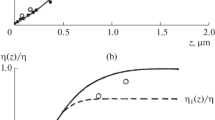Abstract
This paper presents a new BRDF model allowing the simulation of the optical behaviour of multilayer systems formed of homogeneous and isotropic thin films with random rough boundaries. The boundaries are supposed to be locally smooth and generated by a stationary and isotropic Gaussian process. Moreover, it is assumed that they are mutually independent from the statistical point of view. The BRDF is composed of three terms: specular, directional diffuse and uniform diffuse terms, and accounts for interference, diffraction and polarization effects. The expressions for the specular and directional diffuse components are derived analytically, by means of the Abeles formalism, within the framework of the Kirchhoff theory of diffraction. We present pictures of composite multilayer materials obtained by incorporating this model in a spectral ray-tracing algorithm.
Access this chapter
Tax calculation will be finalised at checkout
Purchases are for personal use only
Preview
Unable to display preview. Download preview PDF.
Similar content being viewed by others
References
F. Abelès, “Sur la Propagation des Ondes Electromagnétiques dans les Milieux stratifiés”, Ann. De Phys., 12ème série, vol. 10, pp. 505–581, 1948.
P. Beckmann and A. Spizzichino, “The Scattering of Electromagnetic Waves from Rough Surfaces”, Pergamon Press, 1963.
M. Born and E. Wolf, Principles of Optics-Electromagnetic Theory of Propagation, Interference and Diffraction of Light, sixth (corrected) edition, Pergamon Press, Oxford, 1980.
P. Callet, “Physically Based Rendering of Metallic Paints and Coated Pigments”, Visualization and Modelling, R. Earnshaw, John Vince and Huw Jones, Academic Press, pp. 287–302, 1997.
Commission Internationale de l’Eclairage, International Lighting Vocabulary, CIE 17 (E-1.1), Paris, Troisième édition, 1970.
J. Dorsey, A. Edelman, J. Legakis, H. W. Jensen, H. K. Pedersen, “Modeling and Rendering of Weathered Stone”, ACM SIGGRAPH’99 Conference Proceedings, 1999.
J. S. Gondek, G. W. Meyer and J. G. Newman, “Wavelength Dependant Reflectance Functions”, Proceedings of Siggraph’94, p. 213–220, Orlando, Florida, 1994.
P. Hanrahan and W. Krueger, “Reflection from Layered Surfaces due to Subsurface Scattering”, Proceedings of SIGGRAPH ’93, pp. 165–174, 1993.
H. W. Jensen, J. Legakis and J. Dorsey, “Rendering of wet materials”, Rendering Techniques ’99, Proceedings of The Eurographics Workshop, Grenada, 1999, pp.273–280.
X. D. He, K. E. Torrance, F. X. Sillion et D. P. Greenberg, “A Comprehensive Physical Model for Light Reflection”, Computer Graphics Vol. 25(4), ACM SIGGRAPH’91 Conference Proceedings, 1991.
E. Hecht, Optics, Addison-Wesley Publishing Company, 1987.
I. Icart and D. Arquès, “An Illumination Model for a system of Isotropic Substrate-Isotropic Thin Film with Identical Rough Boundaries”, Rendering Techniques ’99, Proceedings of The Eurographics Workshop, Grenada, 1999, pp.261–272.
G. W. Meyer, “Wavelength Selection for Synthetic Image Generation”, Computer Vision, Graphics and Image Processing, vol. 41, 57–69, 1988.
J. A. Ogilvy, Theory of Wave Scattering from Random Rough Surfaces, Institute of Physics Publishing, Bristol and Philadelphia 1991.
I. Ohlídal and K. Navrátil, “Scattering of Light from Multilayer Systems with Rough Boundaries”, Progress in Optics, 34, Elsevier Science, 1995.
E. D. Palik, Handbook of Optical Constants of Solids, Academic Press, 1997.
G. Rougeron and B. Péroche, “Color Fidelity in Computer Graphics:a survey”, Computer Graphics Forum, 17, pp. 1–13, 1998.
J. Stam, “Diffraction Shaders”, Proceedings of SIGGRAPH ’99, pp. 101–110, 1999.
Author information
Authors and Affiliations
Editor information
Editors and Affiliations
Rights and permissions
Copyright information
© 2000 Springer-Verlag Wien
About this paper
Cite this paper
Icart, I., Arquès, D. (2000). A Physically-based BRDF Model for Multilayer Systems with Uncorrelated Rough Boundaries. In: Péroche, B., Rushmeier, H. (eds) Rendering Techniques 2000. EGSR 2000. Eurographics. Springer, Vienna. https://doi.org/10.1007/978-3-7091-6303-0_32
Download citation
DOI: https://doi.org/10.1007/978-3-7091-6303-0_32
Published:
Publisher Name: Springer, Vienna
Print ISBN: 978-3-211-83535-7
Online ISBN: 978-3-7091-6303-0
eBook Packages: Springer Book Archive




